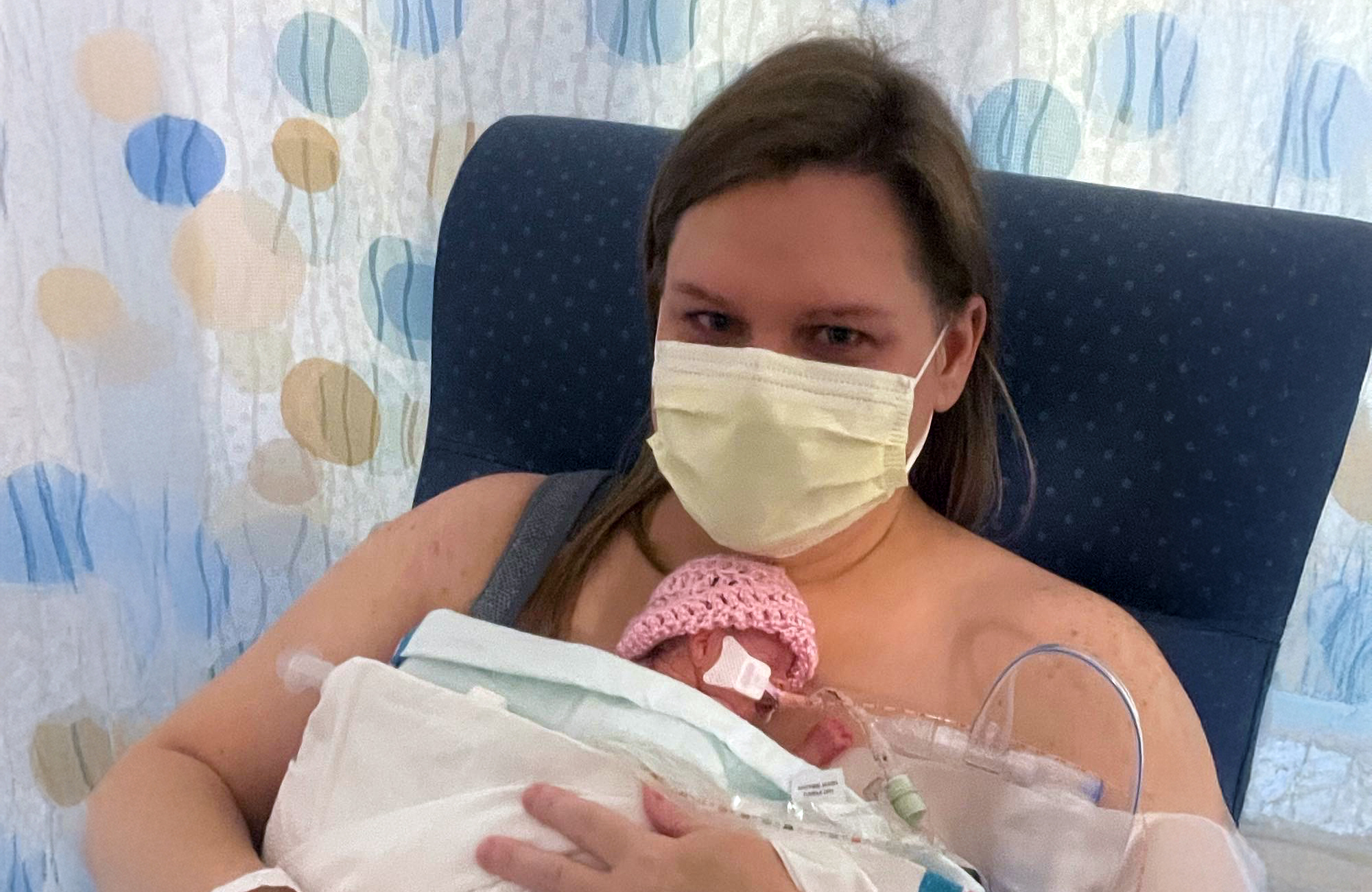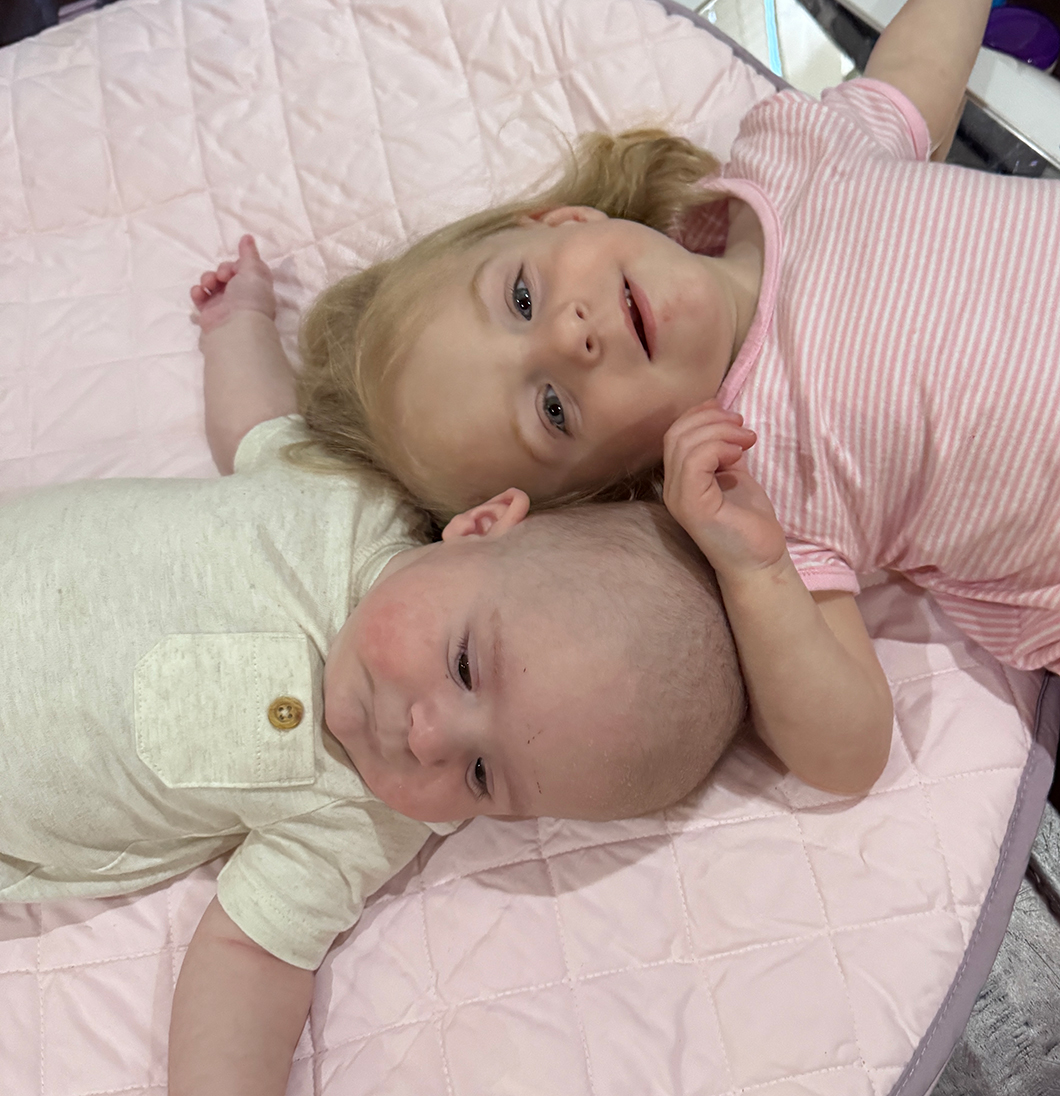How Ashley Beat Endometrial Cancer and Built Her Family

Through a series of coincidences and a healthy dose of determination, Ashley got a second opinion – and a second chance of building her family.
Now, she’s not only a cancer survivor but a mom of two. At LSU LCMC Health Cancer Center, we’re proud to have played a role in Ashley’s journey. By using a fertility-sparing treatment that prioritized Ashley’s wishes, her story proves that hope, persistence, and the right care team can lead to extraordinary outcomes.
From Trying for a Family to a Cancer Diagnosis
When Ashley and her husband decided they wanted to start a family, she knew there’d be some hurdles. She has polycystic ovary syndrome (PCOS) and type 2 diabetes – both of which can make it harder to get pregnant.
Despite these conditions, everything looked normal. But after about a year of trying to get pregnant with no success, she went back to her obstetrician (OB). Ultrasound monitoring confirmed she was ovulating every month, and there were no issues with other factors she needed to get pregnant.
"I just was not getting pregnant,” she says. “So, we said, okay, maybe it’s my husband.”
But everything checked out with her husband, too. They weren’t sure about going the in vitro fertilization (IVF) route, but they figured it was worth getting started. Before moving any further, her care team performed a procedure called a sonohysterogram, which checks the inside of the uterus for issues while it’s filled with saline. This avoids any complications that can arise during IVF.
During this procedure, they found a polyp (a small growth of cells). Ashley, who had just been diagnosed with malignant melanoma two years prior, was immediately on guard.
“I knew this was not good,” she recalls. “But the doctor kept saying it's probably benign. 99% of them are benign.”
On New Year’s Eve 2020, her doctor removed the polyp and surrounding tissues using a dilation and curettage (or D&C) and a hysteroscopy, both of which can help diagnose uterine conditions. The next day – New Year’s Day – she headed to the office to get her results.
“Normally, the nurses in the office are pretty sweet. They’re really chipper,” she says. “They were all quiet. I told my husband, ‘Something’s wrong.’”
Ashley’s doctors informed her and her husband that the polyp came back cancerous. She had endometrial adenocarcinoma.
Endometrial cancer is cancer that starts in the cells of the endometrium, or the inner lining of the uterus. In Ashley’s case, it was caused by an excess of estrogen. Her diagnosis was a shock, as she wasn’t experiencing any of the typical symptoms of endometrial cancer, like vaginal bleeding and pelvic pain.
When Ashley’s doctor told her that the typical course of action is a full hysterectomy, which removes the uterus and therefore Ashley’s chances of getting pregnant, she was devastated.
“I’m bawling my eyes out because, how did we go from, ‘Your body is working, and you can probably get pregnant with a little more special care’ to ‘Now you have cancer’?” she says.
Ashley told her doctor that she needed time to think. “You’re basically taking my fertility here.”
The next day, Ashley took off work and had what she calls a “pity party.” “I cried, I ate ice cream, I watched Netflix,” she says. “The next day I got online, I got my pathology results, and I literally googled every single word of what it meant.”
She learned more about her condition. She found online support groups who offered different perspectives and small ounces of hope. She also came across information about fertility-sparing treatment options, which don't involve removing her uterus and chances of getting pregnant.
“I thought, ‘Wow, I still have a chance,’” she says.
A Welcome Coincidence and Fertility-Sparing Cancer Treatment
Amidst her current situation, Ashley needed to maintain follow-up care for her earlier diagnosis of melanoma. For this, she was seeing a local oncologist in Lafayette. “I went to go see her, and she saw my records,” Ashley recalls. “She said, ‘I'm pretty sure you probably don't want this right now.’”
Ashley’s oncologist happened to have gone to medical school with Dr. Tara Castellano, Gynecologic Oncologist, LSU Health Sciences Center Department of Obstetrics and Gynecology. She asked if Ashley wanted a referral, and Ashley said yes.
Equipped with her newfound online knowledge and another option, Ashley began to regain hope. At her first appointment with Dr. Castellano, her hope grew stronger.
“She came in, sat down, and said, ‘Look, there’s five criteria for fertility sparing. I know you want a baby. You qualify for all five. Do you want to proceed?’” she says.
Ashley said yes. From there, things moved quickly. She was put on a medication called megestrol, which treats endometrial cancer by slowing the growth of cancer cells. This was followed by another D&C and the insertion of an intrauterine device (IUD). The IUD would counteract any extra estrogen.
Because Ashley’s cancer did not go past the lining of the uterus, she did not need other treatments, like chemotherapy or radiation. “I was so lucky that it was contained just to that polyp,” she says.
Ashley would also need to have biopsies (which remove cells to test for cancer) and another D&C. If everything was clear, they would give her the green light to begin IVF and try for a baby.
In November 2021, just 10 months after her cancer diagnosis and being told she would need a full hysterectomy, Ashley was cancer free. What's more, she still had a chance of becoming pregnant. From there, she started the process of IVF – and her journey toward becoming a mom continued.
IVF, Getting Pregnant, and Becoming a Mom
That same November, Ashley underwent an egg retrieval to collect eggs for fertilization. In mid-January 2022, she went on medication to thicken the lining of her uterus, which would prepare her body for the implantation of an embryo (a fertilized egg), and a low-estrogen birth control medication to avoid getting pregnant before the transfer took place. Finally, they did progesterone injections, which also helped prepare the body for implantation.
“On February 8th, we transferred my daughter,” she says. On July 13th, 2022, Ashley’s daughter, Mabel, was born prematurely at 24 weeks and 6 days. This was unrelated to cancer or IVF. Now, she is 2 years old and thriving.
“She's small for a 2-year-old, but she speaks in complete sentences, knows her colors, numbers, alphabet,” Ashley says. “She's great. She’s our true little miracle.”
While Ashley is incredibly grateful for her daughter, she knew she wasn’t done building her family, which is something Dr. Castellano was already aware of. “We made a deal. She was in support of my wish to try and get pregnant again,” Ashley says.
When Mabel turned one, they restarted the process. “We did biopsies. We did a D&C. We did an MRI. Everything came back negative. Everything was clear. There were no cancer cells anywhere that they could see,” she says.
Ashley took the required medications to prepare for IVF and they transferred her son. On June 6th, 2024, Theodore was born. Theodore was also born prematurely at 32 weeks due to Ashley’s preeclampsia (a blood pressure condition that can occur during pregnancy).
Now, Theodore is healthy and thriving. “My daughter is 22 pounds, and she’s 2. He’s 14 pounds, and he’s 5 months,” she laughs.
Getting pregnant and becoming a mom has meant the world to Ashley, and it’s something she attributes significantly to Dr. Castellano and her care team. “Every time I send her a message, I send a picture of the kids. At the bottom, I always thank her,” she says. “I can’t thank her enough for giving us the opportunity.”
A Future Focused on Family

Ashley’s body has been through a lot, and everyone agreed it was time to give it some rest.
“Next year, we plan to have my uterus removed,” she says. But Dr. Castellano is going to perform the procedure so Ashley can keep her ovaries, which is important to her. “That's a big thing that I know other doctors would not have allowed. I am only 41, so it’s a bit soon to go through menopause just yet.”
With Ashley’s IVF journey being complete, there are two embryos left. Ashley and her husband have decided to put them up for adoption at their IVF clinic.
"Hopefully, someone else that's going through fertility issues can have their own little baby because that's really special,” she says. “I was given a great opportunity, and I want to bless another couple, whoever, whatever they may look like. People deserve to have happiness in their lives. And if a child brings happiness in their life, then that's what they deserve.”
Ashley's journey is a testament to the power of resilience, self-advocacy, and the life-changing impact of second opinions. She not only overcame a daunting cancer diagnosis, but she has also found a way to help others on this journey.
Today, Mabel and Theodore serve as a daily reminder of the strength it takes to fight for what matters most. In the face of uncertainty, Ashley was able to use hope and the power of medicine to build a more beautiful future than she could have imagined.
Do you have questions about treatment for endometrial or other types of cancer? Contact us or find a LCMC Health Hospital for your cancer care.
